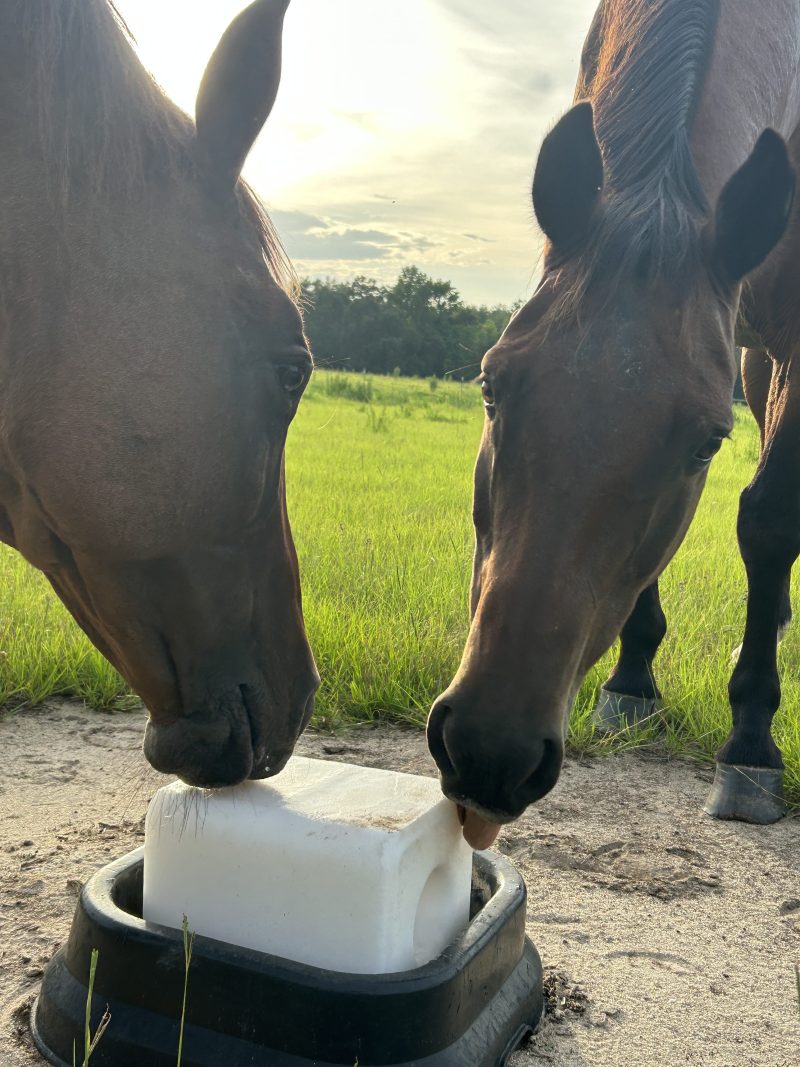Brett Capra, University of Florida, Senior in Animal Sciences & UF/IFAS Extension Intern with Kalyn Waters, UF/IFAS Extension Holmes County, and Carissa Wickens, UF/IFAS Horse Extension Specialist
When it’s hot outside, horses will sweat a lot to help keep cool. According to Iowa State University, horses can lose more than 2.5 gallons of water per hour when trotting and cantering under high temperatures and humidity. This causes them to lose important nutrients such as Sodium and Chloride, the primary minerals in sweat. Deficiencies in these minerals can lead to problems such as dehydration, muscle cramps, and sometimes even more serious health issues such as colic. Fortunately, both of these minerals can be supplemented to horses by providing access to salt.
Natural feedstuffs, such as pasture grasses and hay, have a very low sodium content, usually less than 0.1%. Moreover, commercial feeds typically contain only around 0.5-1% sodium. In terms of requirements for Sodium and Chloride intake, an 1100 lb. horse on a cool day will need around 10g of Sodium and 40g of Chloride. 30g of Salt or about two tablespoons can provide the required amount of sodium for your horse. Yet, when temperatures and exercise levels increase, this requirement can quickly double or triple.
Salt is a very important ingredient for horses, as it provides the Sodium and Chloride needed to support normal nerve function, muscle movement, and digestion. A salt lick is a block of salt that is fed free-choice and is consistently avaialbe. Salt consumption encourages horses to drink water; so, it is a good idea to place salt licks near a water source. There are also different types of salt licks to consider:
- Plain white salt blocks – These are made of pure sodium chloride (NaCl), which is the most essential electrolyte horses need to replace, especially during hot weather or heavy work. While inexpensive and readily available, plain white salt blocks may not be enough for horses in mineral-deficient areas or those with higher nutritional demands.
– - Mineral blocks with added nutrients – These blocks contain salt plus added trace minerals like zinc, copper, selenium, manganese, and sometimes vitamins. They help fill in common trace mineral gaps, especially in regions with poor soil or hay quality. However, the mineral content is often very low, so horses would need to consume large amounts to meet their full mineral requirements. Horses don’t crave trace minerals like they do salt, so they might not lick enough to benefit.
– - Natural Himalayan salt – These salt licks contain sodium chloride with small amounts of other minerals like iron, magnesium, and potassium. Additionally, they are often more durable and weather-resistant, and some horses prefer the taste and will consume salt more willingly. Trace minerals are still in small amounts, however, thus this form of salt is not a suitable substitute for a balanced mineral supplement.
–
Whichever version you choose, make sure it’s accessible and placed in a dry area where your horse can use it whenever they need.
The amount of salt a horse needs depends on the amount of exercise they are getting. Horses working hard in hot, humid weather may also need some extra supplementation. It’s important to monitor the use of the salt lick, so if your horse does not readily consume salt from the block, you can offer a few tablespoons of loose salt in their feed daily. Your horse may need time to adjust to this change with their feed, however, so it would be good to start with 1 tablespoon and gradually increase the amount. It’s also good practice to ensure the horse always has fresh, clean water available.
In summary, during hot weather, salt licks help horses replace vital electrolytes lost through sweat, supporting hydration, muscle and nerve function, and overall performance. Salt licks can also be a very affordable option, usually priced around $2.50-3.50 per pound of salt rock. Because intake from blocks can vary, adding loose salt directly to feed ensures consistent consumption to support the overall health of recreational and performance horses through the hot summer months. Salt intake can also encourage drinking and hydration during the colder winter months as well.
–
For more information, you can visit:
The Nitty Gritty on Salt – Kentucky Equine Research
Electrolytes and the Exercising Horse | Iowa State University Extension and Outreach Equine Science
- Big Doe Contest Returns for 2025: A Growing Thanksgiving Tradition - November 14, 2025
- UF/IFAS Extension Panhandle Cattlemen’s College Announces Scholarship Opportunity for Florida Youth – Application Deadline September 15 - August 29, 2025
- Foot Rot Prevention and Treatment for Cattle - August 15, 2025

